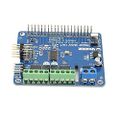Difference between revisions of "Holonomic Robotic Platform"
Joelmartin (talk | contribs) |
Joelmartin (talk | contribs) |
||
| Line 11: | Line 11: | ||
===[https://www.amazon.com/gp/product/B0721MTJ3P/ref=ppx_yo_dt_b_asin_title_o00_s00?ie=UTF8&psc=1 Raspberry PI Full Function Servo Motor HAT Controller]=== | ===[https://www.amazon.com/gp/product/B0721MTJ3P/ref=ppx_yo_dt_b_asin_title_o00_s00?ie=UTF8&psc=1 Raspberry PI Full Function Servo Motor HAT Controller]=== | ||
[[File:Motor_HAT.jpg|120px|thumb|right|Geekworm HAT]] | [[File:Motor_HAT.jpg|120px|thumb|right|Geekworm HAT]] | ||
| − | *Full function Robot Expansion Board (Support Stepper / Motor / Servo) for Raspberry Pi | + | *Full function Robot Expansion Board (Support Stepper / Motor / Servo) for Raspberry Pi. |
*Stepper motors are great for (semi-)precise control, perfect for many robot and CNC projects. | *Stepper motors are great for (semi-)precise control, perfect for many robot and CNC projects. | ||
*HAT supports up to 2 stepper motors. The python library works identically for bi-polar and uni-polar motors | *HAT supports up to 2 stepper motors. The python library works identically for bi-polar and uni-polar motors | ||
| − | *For a complete in-depth | + | *For a complete in-depth explanation of using this HAT see the [http://www.raspberrypiwiki.com/index.php/Robot_Expansion_Board Raspberry PI Wiki: Robot Expansion Board]. |
Revision as of 20:36, 1 January 2020
Engineering Project Data
Mechanical
Drive Motors with Gearboxes
Hardware Case for Raspberry PI 4
Electronic/Electrical
Raspberry PI4 4 Gig Ram
Raspberry PI Full Function Servo Motor HAT Controller
- Full function Robot Expansion Board (Support Stepper / Motor / Servo) for Raspberry Pi.
- Stepper motors are great for (semi-)precise control, perfect for many robot and CNC projects.
- HAT supports up to 2 stepper motors. The python library works identically for bi-polar and uni-polar motors
- For a complete in-depth explanation of using this HAT see the Raspberry PI Wiki: Robot Expansion Board.
HDMI Video Adapter Cable
Micro SD 64 Gig Memory Card for PI Operating System, and Hard Drive
Software
Raspbian Operating System
Balena Flash Prom Programmer
Windows Python for Laptop Host Development
Spyder Development Environment
Spyder is a powerful scientific environment written in Python, for Python, and designed by and for scientists, engineers and data analysts, featuring the following options:
- Editor
- IPython Console
- Variable Explorer
- Profiler
- Debugger
- Help
Code and Mathematics
Code to Facilitate Development
To help easy development of specific modules in the Holonomic Robot, a communications interface is implemented between the Robot(Raspberry PI 4 Server) and a Laptop Development workstation(HP Client). The protocol is built on TCP Tx-Rx Exchange between the two devices. The code modules are Python running at both ends. The Robot starts out as a purely slaved device taking commands from the laptop. Motor control modules manipulating the GPIO interface run on the Robot but are commanded by the laptop. As the motor control is refined and routinized along with the growth of intrinsic autonomy, the code is transitioned from the Laptop to the Robot. Code is primarily developed in Python 3.7.
Laptop Code for Robot/Laptop Base Communication
import socket
message_from_server = ''
client = socket.socket(socket.AF_INET, socket.SOCK_STREAM)
client.connect(('192.168.1.43', 13000))
while True:
message = ''
message = input('Input lowercase sentence:')
client.send(message.encode())
message_from_server = (client.recv(4096)).decode()
print (message_from_server)
if message == "Stop the Server" : break
client.close()
print ("You ended the session")
Robot Code for Robot/Laptop Base Communication
import socket
serv = socket.socket(socket.AF_INET, socket.SOCK_STREAM)
serv.bind(('192.168.1.43',13000))
serv.listen(5)
while True:
conn, addr = serv.accept()
message_from_client = ''
while True:
data = conn.recv(4096)
if not data: break
message_from_client = data.decode()
print ("Tx:" + message_from_client)
message = "RxAck:" + message_from_client
conn.send(message.encode())
conn.close()
if message_from_client == "Stop the Server" : break
print ('Communication protocols termintated at Server by Client')



